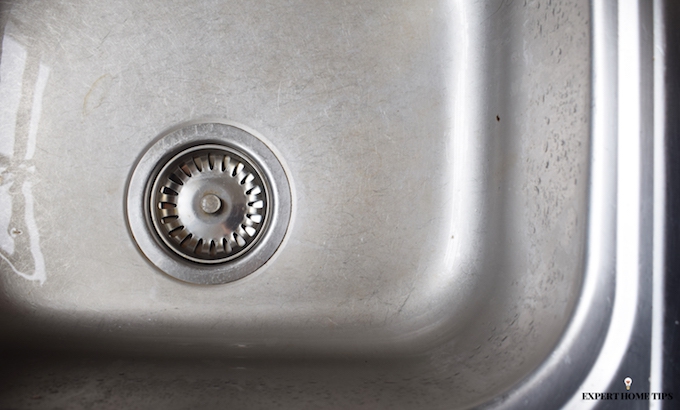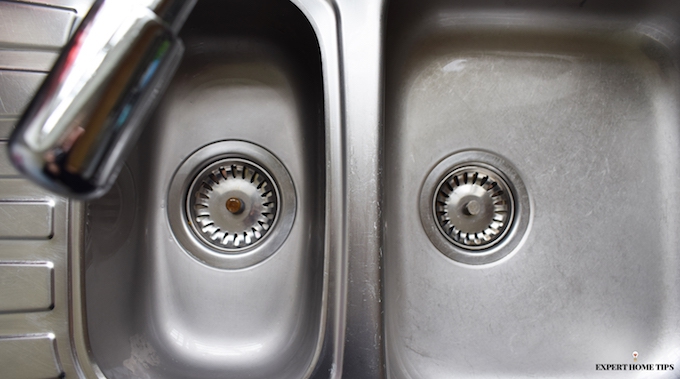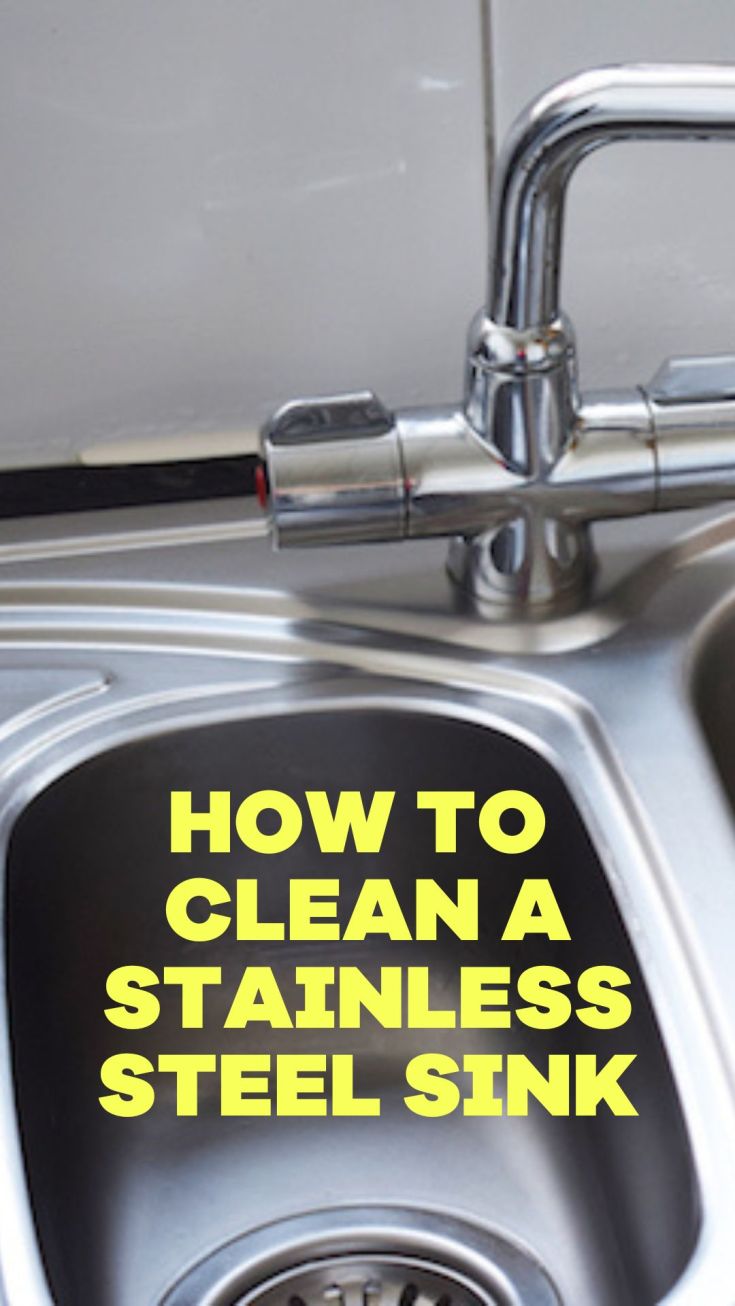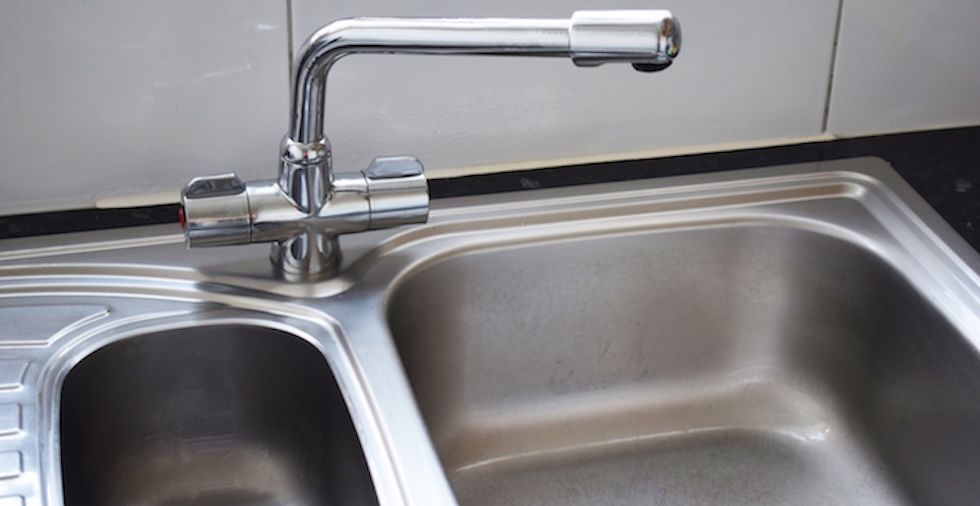Does your stainless-steel sink look stained, dull, or covered in hard water stains? Maybe it’s starting to look more like brushed grey than sparkling steel. Don’t panic. Today, we’re going to show you exactly how to clean a stainless-steel sink and get it looking like new. The best part? We’re using safe, simple ingredients you probably already have at home.
We'll show you the step-by-step method to get stainless steel shiny, spotless, and streak-free—and we’ll also share our top-secret ingredient that takes things to the next level. These tricks don’t just work on sinks. You can also use them on stainless steel appliances, such as fridges, hobs, or extractor fans.
Editor's Note: This post was originally posted in May 2017 and has been completely revamped and updated for accuracy and comprehensiveness in November 2025.
Why use natural methods?

You might be wondering, why not just use a store-bought stainless steel cleaner? Well, natural cleaning methods have some significant advantages.
- First of all, they’re cheaper. Baking soda and vinegar cost pennies compared to branded sprays.
- They’re also safer - no harsh chemicals, no irritating fumes, and reduced risk when it comes to children and pets.
- Lastly, they’re eco-friendly. Cleaning products often release chemicals that can end up in waterways, harming marine life. Natural ingredients are much kinder to the environment.
Before we show you how easy it is, you just need to know what to avoid when cleaning stainless steel sinks.
Get it wrong, and you risk damaging the material or leaving smeary marks. Always avoid using harsh scouring pads or strong cleaning products, such as bleach. We recommend gentle abrasives and natural products for the best finish. If you’re opting for a commercial cleaner, always check it’s suitable for stainless steel first.
How to deep clean a stainless steel sink
1. Prep the sink
Start by emptying the sink and clearing the draining board. You’ll want to get rid of any mess and debris. We’re talking bits of food scraps and crumbs. If you haven’t cleaned your sink in a while, you might find a bit of buildup. You’ll only end up pushing the dirt around and making the job harder, so take the time to tidy up. It’ll make cleaning much easier.
2. Rinse the sink
Next up, it’s time to rinse. We suggest using a bowl of warm water mixed with a small amount of washing-up liquid to rinse the entire area. Failing that, you can simply run the tap, but adding soap will help degrease and break down any grime.
When you take these two steps to get started, you will find that you have a clean sink environment to get things moving.
Got a blockage? Find out how to get hair out of a drain in our easy guide.
Step 3: Clean with baking soda
Now the real cleaning begins! Generously sprinkle baking soda all over your stainless steel sink, including the draining board. Baking soda is mildly abrasive, which means it lifts stains, water marks, and stuck-on grime without scratching the steel.
Take a soft sponge or cloth and dampen it with lukewarm water. It’s essential not to use a rough scouring pad or steel wool, as this can damage the finish. Gently scrub in circular motions as you wipe the baking soda off. As the baking soda and the water combine, it’ll start to form a thick paste.
Don’t forget to scrub the back side of the sink! You might notice some limescale buildup around the back of the tap, so make sure to give that area a good scrub.
Another area that people often forget is the grooves around the plug hole. We like to use an old toothbrush to scrub all the cracks and crevices. Food can get stuck around here, so this will help clear any unwanted odours.
4. Rinse the sink again
Once you’ve scrubbed away the grime, give the sink another quick rinse, being sure to clean the baking soda off. Use a wet cloth to make sure there’s no residue left behind on hard-to-reach areas, like the draining board.
5. Clean with lemon
Lemon juice, or citric acid, can be used as a handy cleaner. Cut a lemon in half and use it like a sponge, rubbing the fruit directly on the stainless steel. As you work, you will notice that the juice begins to flow from the lemon.
The citric acid in lemon juice helps break down stains and even has some antibacterial properties. Plus, it leaves a fresh citrus scent that instantly makes your kitchen feel cleaner.
6. Rinse again!
You’ll want to be careful not to leave the lemon juice on for too long, as prolonged contact can dull the finish. Use warm water to give the sink another rinse to wash away the lemon juice. You’ll want to act fast, so the acid doesn’t cause any damage.
7. Clean with white vinegar
If you’re struggling with water stains and limescale, don’t panic. We’ve got a trick up our sleeve for stubborn stains. Mix equal parts white vinegar and warm water, and apply to a clean cloth. Use the cloth to clean any stains off the sink. You might need a little elbow grease now. Vinegar is safe in small amounts and brilliant for dissolving limescale, but always rinse thoroughly afterwards – you don’t want it to sit on the stainless steel for too long.
If you’ve got limescale buildup on your tap, you can use vinegar to remove it, too. Soak a cloth in undiluted white vinegar and wrap it around the tap. Leave it to sit for 10 minutes for light limescale, up to 1 hour for heavy limescale. Don’t leave it any longer than that, or it could dull the finish or even corrode the surface.
Remove the cloth and use an old toothbrush or a sponge to scrub the loosened limescale away. Rinse thoroughly to wash away the vinegar residue. Look at the difference!
8. Dry the sink
Don’t neglect this step! To achieve the ultimate shine, use a dry microfiber cloth to buff the surface dry. This is how professional cleaners get that impressive streak-free finish.
9. Use mineral oil to make it shine

You might be wondering, how do you shine a dull stainless steel sink? Can I make it look new again? Here’s a cleaning secret we think everyone should know. Get a clean, dry microfibre cloth and pour on a drop of mineral oil. Work the oil into the sink in the direction of the steel grain to avoid streaks. This step not only makes the surface gleam like new but also helps repel future water spots. Baby oil works well, too!
And that’s how you clean a stainless steel sink! With these natural cleaning methods, your sink will go from dull and stained to shiny and spotless in just a few steps. You can achieve excellent results in as little as 15 minutes, so what are you waiting for?
For more amazing cleaning tips just like this one, plus great competitions, sign up to the Expert Home Tips newsletter today.
Q&A
Do you have a burning question that we haven’t covered? Don’t worry. We’ve got your back. Here are some of the frequently asked questions:
Will vinegar ruin stainless steel sinks?
The short answer is that it depends on how you use it. Using a small amount of vinegar to clean a sink should not be a problem, especially if you rinse well afterwards. However, you should not leave large amounts of vinegar on stainless steel. Over time, this substance may start to corrode the metal. Avoid this mistake at all costs.
How can I make stainless steel look new again?
Our simple cleaning guide will help you make your stainless steel sink sparkle. When you want to make the metal shine, one of the best cleaning tips is to use some mineral oil. Doing so will help the metal to look as good as new once more. Give it a go!
How do you shine a dull stainless steel sink?
As we have covered, you can use some mineral oil to make the stainless steel sink shine again. However, it's essential to make sure the sink is dry first. Give it a good buff with a clean, dry microfibre cloth first.
What will damage stainless steel sinks?
You may already know that stainless steel can be delicate. Using the wrong cleaning products could damage the metal's surface. You want to avoid harsh materials, such as scouring pads. In addition, you should avoid harsh cleaning products. If you are using a commercial cleaner, check that it is suitable for stainless steel first.
Stainless steel looks so much better when it's sparkling! Will you be trying our tips? Leave a comment below.


340 grams of bicarb? Really? That's nearly two pot fulls of the stuff.
Hi Julie. This is to make a DIY cleaning product that will last for a long time, over several months. The quantities, can, of course be halved to suit your needs. Thanks :)
Hi, do you have a tip on how to keep a cream one of those plastic type Sink clean, it was lovely when new! But I only have to empty the teapot and I swill the sink straight away and it's stained again and only bleach will remove it, I have tried filling it with biological washing powder, soda crystals, scouring it with cif, and in one Afternoon it back looking like its never been cleaned for a month, PLEASE HELP
Hi Anne. Have you tried bicarb? Salt may scratch the plastic so I wouldn't recommend that, but bicarbonate of soda is a very powerful cleaner that may just do the trick!
fantastic love these natural cleaning solutions there great and this on really works wow my sinks are ace thank you so so much x
Hi Lynette. I was SO impressed with the results too - glad you liked it! :)
I will most certainly be trying this today ! Thanks for the tip.
Hi Karen. Let me know how you get on!
Put a scoop of stain remover, any brand . Fill with boiling water and leave . The oxygen in the stain remover lifts all stains and grease out and after halfhr. Drain and rinse sink without any rubbing. Your sink will look brand new.
Hi Roger, Thanks for sharing this unique tip with us. We've not tried it before, but it sounds extremely simple and easy to do - we'll definitely be giving it a go! Thanks :)
But is stain remover as ocean friendly I wonder?
Does this tough duo also work on cleaning stubborn dirty baths and sinks (not stainless steel!)? Or is there another `natural`alternative? Look forward to your great advice!
Hi Evelyn. This would certainly work on a ceramic bath sink, however it can be quite abrasive, so if you're using it on your bath, I'd recommend scrubbing with the green side of a worn sponge. I hope this helps, and do let us know how you get on!
Thank you never done this and its cleaning day so giving it a go xx
Happy cleaning, Alison!
Hi, I use your tip for the stainless Steel sinks. Because of the large quantities I use 2 teaspoon baking soda to 1 teaspoon salt in my small sink in the caravan. Works a treat.
Great idea, Ruth! This recipe does make quite a large batch for frequent use.
A simpler effective and cheaper way is rubbing half a fresh lemon all around your stainless steel sink, leave 5-10 minutes if you wish, then rinse with boiling water. Buff if wish with dry microfiber cloth. Not only will it look clean and shiny, it will smell great too. Eau natural cost between 12-16p.
Great idea!
How can I get my bathroom tiles back to shiny? I live in a very hard water area and limescale is everywhere. I'm sure the baking soda and salt would work but the tiles are on the wall so I'm a bit stumped.
Hi Sharon! Have you heard of dish mates? They're sponges that hold cleaning products in the handles. Normally you fill it with washing up liquid and use to wash dishes, but they're also really good for cleaning tiles. You could fill with any cleaning solution, but I find that flash works the best. Once cleaned, go over with a squeegee and/or a buffing cloth.
Hi I have a black sink in colour and despite trying every product on the market it always looks grey. Any suggestions please
Hi Jennie! Try using a mixture of equal parts white vinegar and warm water to clean the sink or a specialized sink cleaner. Avoid using abrasive cleaning materials such as steel wool or scouring pads. If none of the above works, you can use a polishing compound specifically for black sinks to restore shine.
Would this method work with a stone sink?
We recommend using a mild, PH-neutral cleaner for stone sinks. You could try washing up liquid or castile soap with a sponge. You can also make a paste with baking soda and water for tougher stains. With either of these methods, be sure to rinse well after cleaning.
We're replacing our kitchen faucet and so there was a lot of lime build up around where the old faucet had been. Since I didn't want to make such a huge batch in case it didn't work, I halved the recipe using grams to Tablespoons, and then Tablespoons to cups converters and ended up with 1-1/8 C baking soda to 1/4 + 1/8 C salt. It maybe took away only ~2% of the lime deposits, so we still had a lot left. Maybe converting and halving the recipe was my problem - ? Regardless, the thing that finally worked for us was to sandpaper the stainless steel (it has no finish or coating, so it didn't damage anything) and then go over it with a metal polish. But even without the polish, the sandpaper did pretty well at eliminating the lime deposits. So I love the baking soda / salt idea, but either our lime stains were no match for it OR my mixture was off. :(
If you had to use sandpaper, it sounds like you had some pretty heavy limescale deposits! We're glad you found a solution.
any oil will shine up stainless steel - it doesn't have to be olive oil. Any cooking oil, baby oil or mineral oil will do the same job. apply a few drops with a cloth or sponge then polish off.
That's true, though some may be more effective than others. It's essential to remember that using oils containing acidic or abrasive components may damage the steel and its finish.